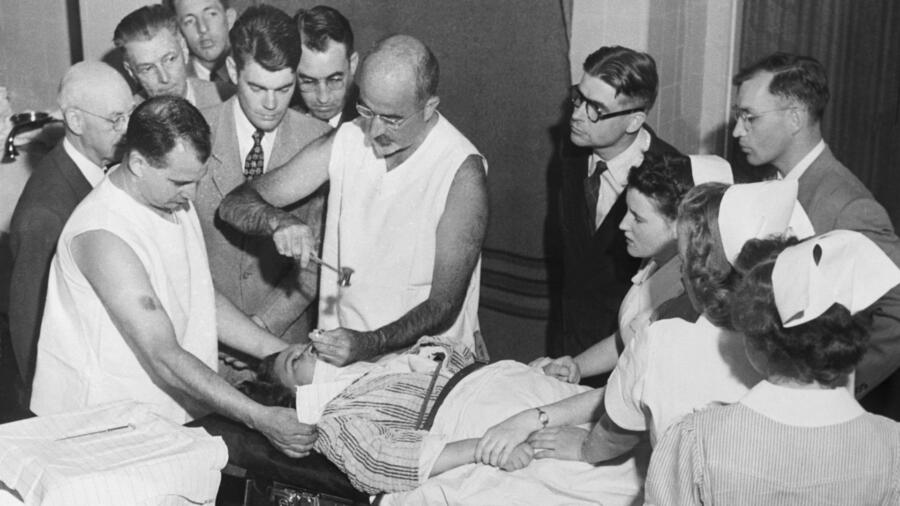It starts with a snap—not of bone or scalpel, but of rope, as a medical student cuts down a freshly hanged man. His heart is still fluttering. His eyes, not yet dimmed. But this isn’t a rescue.
It’s a race to the dissection table.
And it’s only the beginning of medicine’s most monstrous chapter.
In his gripping and unflinching book, The Icepick Surgeon, bestselling author Sam Kean digs into the horrifying world where ambition, curiosity, and cruelty collided. Where science—intended to heal—became a tool for torture, murder, and inhuman experimentation.
Anatomy of Evil: When Discovery Turned to Depravity
Science, when unchecked, has always flirted with darkness. But in the 18th and 19th centuries, physicians didn’t just steal corpses—they created them.
Medical students in Europe and America once stalked the shadows, slicing into the bodies of the poor, the voiceless, the forgotten. Children were dissected. Pregnant women were butchered. And when the graveyards ran dry, the most enterprising men of medicine went hunting.
Some even paid for fresh kills—the murder-for-profit scandal of Burke and Hare in Scotland is still infamous. They supplied “anatomical specimens” to doctors who never questioned their source.
The Lobotomy Epidemic: Dr. Freeman’s Icepick Obsession
No figure embodies the thin line between medical progress and madness more than Dr. Walter Freeman II. His obsession? The lobotomy.
At first, the procedure seemed revolutionary—an operation that could “cure” depression, anxiety, or schizophrenia. But Freeman’s method involved driving an icepick through the eye socket and hammering it into the brain. No anesthesia. No precision. Just brute force.
At his peak, Freeman performed up to 25 lobotomies a day—sometimes with both hands at once. His youngest patient was just 4 years old.
He saw himself as a pioneer. In reality, he left thousands disabled, silenced, or dead.
Auschwitz and the Atrocity of Advancement
Few examples are as horrific—or as ethically damning—as the Nazi medical experiments during World War II.
Doctors like Josef Mengele mutilated, infected, and tortured prisoners—mostly Jews, Roma, and other marginalized groups. They froze victims in tanks of ice, tested poisons, amputated limbs without anesthetic, and injected chemicals into children’s eyes to change their color.
The goal? Pseudo-scientific “data” to bolster Hitler’s twisted ideology.
But here’s the uncomfortable truth: Some of those findings still exist in modern medical literature. Used, cited, debated. Should we benefit from evil—if it saves lives?
It’s a haunting question with no easy answer.
Tuskegee: The Deception That Lasted Decades
Between 1932 and 1972, the U.S. Public Health Service ran one of the most unethical experiments in American history—the Tuskegee Syphilis Study.
Hundreds of Black men in Alabama were promised free healthcare. What they received instead was deliberate neglect. Even after penicillin was discovered as a cure, researchers withheld treatment to track the “natural progression” of the disease.
Their wives were infected. Their children were born with congenital syphilis. All for the sake of research.
The government’s response? Silence—for 40 years.
When the story broke in 1972, it wasn’t through medical channels. It was a whistleblower and a journalist who finally forced the world to look.
When Progress Has a Body Count
Can we separate the benefits of medical science from its bloody foundations?
That’s what The Icepick Surgeon dares to ask. It explores how men and women—respected by their peers—crossed ethical lines for prestige, ambition, or patriotism. And it reminds us that the pursuit of knowledge without ethics is no better than a scalpel without a hand to guide it.
Even now, echoes of that past remain:
- Prisoners experimented on without consent
- Indigenous communities used for vaccine trials
- Black patients ignored, misdiagnosed, or dismissed
The past is not so distant.
Modern Parallels and the Ethics of Today
You might think such horrors are behind us. But bioethics experts warn that the dangers of “bad medicine” never truly vanish. They evolve.
Today, we see it in:
- AI algorithms biased against Black patients
- Fertility clinics abusing genetic material
- Drug trials exploiting vulnerable populations in developing countries
- “Voluntary” studies in underfunded prison systems
As science accelerates, so too does the potential for new abuses. And it begs the question:
“Just because we can—should we?”
The Lesson Beneath the Lab Coat
Sam Kean’s The Icepick Surgeon isn’t just a retelling of dark history. It’s a moral blueprint, a warning cry for future scientists, doctors, and leaders:
Science must serve humanity—not sacrifice it.
Because if we forget what happens when ambition is left unchecked…
We risk becoming part of the next chapter of bad medicine.

